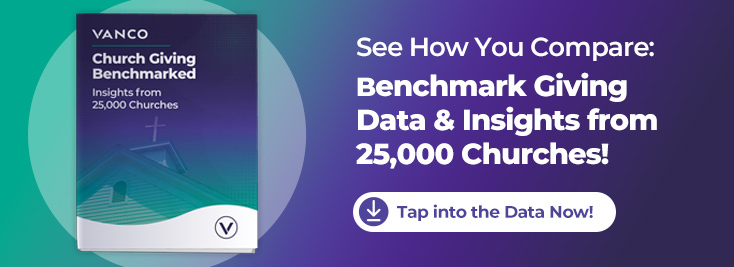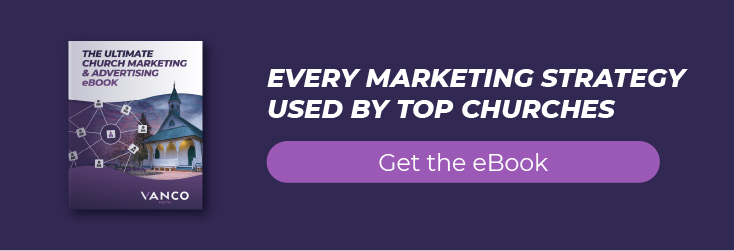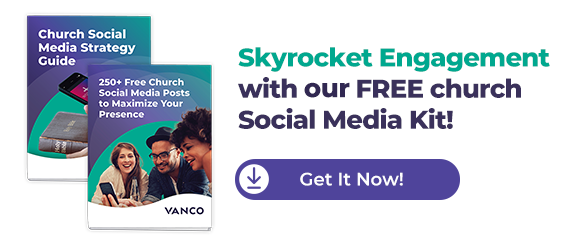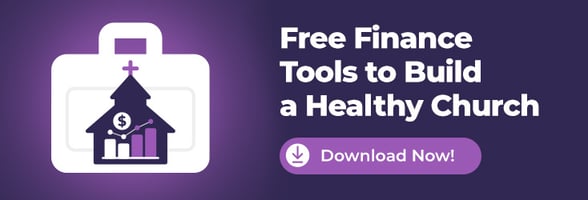Church Giving Stats and Strategies for Adapting to New Trends
Vanco has helped more than 25,000 churches improve their financial stewardship, engage members and inspire generosity with online giving and free materials like these stats. We’ve put together research and data plus actionable strategies your church can use to start growing giving right away!
Want Even More Data?
Go deeper with our free benchmark report, which reveals giving patterns across 25,000 churches, including what’s working, what’s shifting and how churches your size are adapting. Use it to spot opportunities, grow generosity and guide your next steps with confidence.
Get the Benchmark StudyTable of Contents
CHAPTER 1
65 Church Giving and Growth Stats
Our team of investigators conducted a church giving survey of 1,000 churchgoers and combed through reams of data to provide decision makers with the stats they need to plan for the future. We looked at:
Tithing Statistics
1. Only 27 percent of churchgoers tithe at or above the traditional mark of 10 percent of their income and that number has remained largely the same in recent years. Vanco Churchgoer Giving Study
2. Young adults (24–34) are the most likely to give more than 10 percent. Older adults (66–72) are most likely to give less than 4 percent. Vanco Churchgoer Giving Study
3. Average per-capita church giving equated to just about 4.35 percent of household income in 2022 based on average donations versus average income. CareyNieuwhof.com
4. Digital giving continues to grow: about 50 percent of all church donations now come via card or online methods. Enterprise Apps Today
5. In 2024, recurring gifts accounted for 42 percent of digital giving and 57 percent of digital transactions even though many churches didn’t offer the option for this type of giving. Worship Facility
6. Recurring online givers give 120 percent more than nonrecurring online givers and the enhanced value of these givers is visible across all average weekly attendance levels. Vanco Benchmark Giving Study
7. Churches offering digital wallets (e.g., Apple Pay) continues to increase, but Apple Pay and Google Pay usage is flat (13–14 percent) among givers. Vanco Churchgoer Giving Study
8. Overall giving rose in many churches in 2024 and 50–61 percent of churches saw an increase in digital giving, without any decline in traditional cash or check giving. Worship Facility
9. Weekly giving is down from 49 percent in 2015 to 39 percent in 2025. Vanco Churchgoer Giving Study
10. As of June 2025, 17 percent of families reduced their annual giving to church and 50 percent of church giving comes via card or bank. Biblical Christian Worldview
11. A 2022 study found that only about one quarter of congregation members tithe—and 2.5 percent of income is the average giving level. Aplos
12. Directed giving (designating funds to specific church needs) increased from 27 percent in 2015 to 31 percent in 2025, showcasing the desire for givers to contribute to specific causes they feel called to support. Vanco Churchgoer Giving Study
13. Credit and debit cards are the most used digital method for giving among church donors. Vanco Churchgoer Giving Study
Average Giving Per Person in Church
14. Baptists report the highest tithe rates of average giving at around 40 percent, while Methodists sit at about 12 percent, Restorationist/Church of Christ at 17 percent and Lutherans at 19 percent. Roys Report
15. 77 percent of Protestant churchgoers affirm that “tithing is a biblical command that still applies today.” Roys Report
16. Average giving per person in 2022 was $2,848, about 4.35 percent of household income, with the average income being $65,423 in that year. Church Salary
17. Smaller churches tend to have higher per-person giving: churches with about 50 attendees averaged $2,589 annually per person, while those with 5,000 attendees averaged $2,340. Orr Group
18. Hybrid worship model churches (offering both in-person and virtual) saw per capita giving of $2,350, versus $2,048 for in-person–only churches. Lake Institute on Faith & Giving
19. Online-only churches, which are much fewer in number, had a significantly lower per-person giving at $691 annually. Lake Institute on Faith & Giving
20. The average weekly giving per person based on combined attendance is $29.63. Christian Standard
21. The average evangelical donor gave $2,503 to church in the prior 12 months, down 15 percent from the inflation-adjusted $2,953 in 2021. Christian Post
22. Among religious donors in 2023, 60 percent gave $1,000 or more to their congregation and 81 percent gave the same amount or more compared to 2022. Religion News
Percentage of Donations Going to Faith
23. In 2022, giving to religion comprised 27 percent of all charitable dollars, making it the largest recipient category among nonprofit causes. Lake Institute on Faith & Giving
24. Despite nominal growth, giving to religion fell 1 percent when adjusted for inflation in 2023. Stelter
25. In 2023, religious giving made up 24 percent of total contributions, remaining the highest sector share that year. Stelter
26. In 2024, religion again received the highest percentage at 23 percent, although in inflation-adjusted terms, that also declined. PNC Bank
27. As of 2025, the share of donations to religious causes stood at about 25 percent—a large reduction compared to over 50 percent in 1994. Angeletti Group
28. In 2024, faith-based nonprofits received around $146.5 billion, representing approximately 25 percent of all charitable dollars. PRIDE Philanthropy
29. Religious giving had a 5.2 percent nominal increase in 2022, though in real terms (inflation-adjusted), it actually declined 2.6 percent. Lake Institute on Faith & Giving
30. Charitable giving trends show religious causes consistently rank highest at 27 percent compared to other types of causes. Double The Giving
31. The decline in religious giving's share—from over 50 percent to mid-20 percent over decades—reflects a significant shift in philanthropic priorities since the 1990s. The Angeletti Group
32. Annual religious giving totals (circa 2022–2024) hover around $143–$147 billion, aligning with their consistent share of 24–27 percent) of overall charitable donations. Lake Institute on Faith & Giving
Church Online Giving Statistics
33. As of 2025, churchgoers are evenly split between eGivers (50 percent) and Traditional Givers (50 percent). Vanco Churchgoer Giving Study
34. Churches that promoted online giving saw a 32 percent increase in overall donations, underscoring the impact of digital accessibility. Nonprofits Source
35. In 2023, the first year post-2019 largely unaffected by the pandemic, the average annual donation volume for online giving was $24,118 higher than it was in 2019. Vanco Benchmark Giving Study
36. Approximately 30 to 45 percent of donors are “very comfortable” using electronic methods; 21 percent say the same for crypto. Vanco Churchgoer Giving Study
37. 26 percent of churches still lack any online giving option, mostly smaller congregations with less digital infrastructure. Online Giving
38. 62 percent of churches allow donations directly via their website and 54 percent support recurring automatic payments; 50 percent accept bank transfers. Worship Facility
39. eGivers are more likely to be ages 24 to 44, higher-income earners and college/post-grad educated.
40. Approximately 58 percent of church donors prefer to give electronically, compared to 42 percent who still favor traditional (non-digital) methods. ZipDo
41. eGivers contribute more frequently and in higher amounts (19 percent give more than 10 percent of their income). Vanco Churchgoer Giving Study
42. The average electronic donation volume per church has increased 23 percent since 2019. Vanco Benchmark Giving Study
43. 55 percent of church donors prefer giving through mobile apps and 45 percent do so via text messaging, highlighting the importance of convenient, mobile-first options. ZipDo
44. Online givers are more likely to allocate gifts to specific funds (42 percent). Vanco Churchgoer Giving Study
The Most Generous Church Givers
45. 95 percent of practicing Christians (those attending church at least monthly and who consider faith very important) gave to charities in 2022, compared to 68 percent of non-practicing Christians and 51 percent of nonbelievers. Baptist Standard
46. Among those with thriving spiritual lives, average annual giving was $6,216, compared to just $991 among those ailing spiritually. Baptist Standard
47. 69 percent of givers report that generosity was taught to them, versus 56 percent of non-givers. Barna Group
48. Among practicing Christians, 61 percent say Jesus is their primary inspiration for generosity. Barna Group
49. 90 percent of Millennials consider charitable giving essential to their lives. CareyNieuwhof.com
50. In 2022, Millennial church donors gave an average of $439 annually, compared to $696 from Baby Boomers. ZipDo
51. Faith-based donations average about $1,897 annually among African American households—the highest across demographic groups. ZipDo
52. Approximately 69 percent of givers are willing to pay 2-4 percent to cover processing fees, with willingness highest among 24- to 54-year-olds. Vanco Churchgoer Giving Study
53. Most churches report that about 40 percent of their income comes from donors giving $1,000 or more annually. Gitnux
54. In 2023, over 81 percent of religious donors gave the same—or more—to their congregations compared to the previous year. Religion News Service
55. The top 10 percent of Christian donors contribute approximately 70 percent of all Christian giving. Gitnux
56. The highest per-donor donations occur in medium-sized churches, which points to a connection between technological adoption and intimate member engagement. Vanco Benchmark Giving Study
Churchgoer Participation
57. 40 percent of U.S. adults participate in religious services at least monthly—either in person, online, or both. Lifeway
58. Satisfaction with church communication has improved from 46% in 2015 to 57 in 2025. Vanco Churchgoer Giving Study
59. Monthly participation varies by affiliation, across denominations such as Latter-day Saints (80 percent), Evangelical Protestants (71 percent) and historically Black Protestants (66 percent). Pew Research Center
60. The number of Americans identifying as atheist, agnostic or no religion rose from 11 percent in 2003 to 27 percent in 2023. PRRI Census of American Religion
61. According to the EPIC Attender Survey (2024), two-thirds attend weekly and over 80 percent report stable or increased attendance compared to five years ago—especially among newer and younger churchgoers. Faith Communities Today
62. Over 50 percent of churchgoers have attended the same church for 11-plus years, though that figure is declining. Vanco Churchgoer Giving Study
63. 46 percent of churchgoers regularly attend or view multiple congregations and 7 percent identify as having more than one "home" church.
Faith and Leadership
64. Weekly church volunteering rose to 24 percent, up from 15 percent in 2024—with Gen Z (21 percent) and Millennials (19 percent) outpacing Boomers (9 percent), Gen X (11 percent) and Elders (12 percent). Religion News Service
65. Less than half of all U.S. adults are members of a church. Just 30 years ago, that number was at 70 percent. Gallup Poll
Understanding the Content of the Data and What Churches Need To Do To Adapt
There’s a lot of concerning data for churches, but you don’t need to be overwhelmed by it. Next, we analyze the stats and trends, offering actionable strategies to help your church adapt. By reviewing the data and following the actions suggested in this resource, you can help ensure your church remains healthy for years to come.
CHAPTER 2
Church Giving Trends
It’s not news that many churches have been struggling in terms of growing their revenue thanks to the reduced number of churchgoers in the past few years. But there are many ways to improve your membership and finances! And these days, with the increased use of social media, the church’s mission has expanded its reach. Below we give you a look at some revenue and giving statistics from Giving USA to show how churches are steadily climbing up the ladder to gain more churchgoers and revenue.
- In 2024, giving to religion totaled $146.5 billion.
- Religion received 23 percent of all charitable dollars in 2024, which was the largest share among subsectors.
- In 2023, religion still led all causes at 24 percent of total giving, yet 2023 religion giving (inflation-adjusted) was below 2019—the only cause area in that position.
- In 2023, giving to religion rose 3.1 percent nominally, but fell 1 percent after inflation.
- Overall U.S. charitable giving reached $592.5 billion in 2024, the first inflation-adjusted increase in three years.
- Individuals gave $392.4 billion in 2024, which matters because churches rely heavily on individual donors.
- 98 percent of places of worship offered digital giving in 2023 (up from 64 percent pre-COVID).
- In 2024, 50 percent of pastors reported giving matched their budget and 16 percent exceeded budget.
- In 2024, approximately 29 percent of pastors said giving rose compared to the previous year, while 24 percent say it fell.
The percentage of U.S. adults who are members of a church stood at just 37 percent in 2025 (Pew Research). This might seem like grave news, but it isn’t for churches that are willing to adapt. Most U.S. adults still believe in God; they simply don’t belong to a church. One of the main reasons for this is a drop in religious preference. About 89 percent of traditionalists have a religious preference. The numbers drop for each of the following generations, particularly with millennials, only 68 percent of whom have a religious preference (Gallup). This means there’s more openness among younger churchgoers when it comes to choosing a new sect or religion than the ones they grew up with.
In times past, believers generally stuck to the sect of the church they grew up in. Today, churches have a unique opportunity to draw in a wider set of visitors. It is up to each church to make sure these new visitors feel welcome. Unfortunately, most churches don’t have a strategy for assimilating visitors, which is why most visitors won’t return. However, when churches commit to simple strategies like following up with visitors, the chances visitors will return rise significantly. Tony Morgan, a leadership coach for pastors, has found that 90 percent of church visitors will return if someone follows up with them the same day. Even if you can’t follow up with a new visitor the day of their initial visit, it still pays to reach out. Around 60 percent of visitors will come back if the follow-up occurs within a few days after the visit.
One of the main reasons people look to join a new church is to feel the greater connection that comes from a faith community. These visitors want to feel like they belong in this new community and the best way to do that is to take the extra steps necessary to make them feel welcome. If you're looking to engage your visitors, make sure your church welcome committee hands out a welcome packet and materials for new members. In working with tens of thousands of churches over two decades, we’ve found that these materials can do a lot of the heavy lifting. If you don’t have a church welcome packet, you can use many of these free materials to get started.
Because we understand growing membership is a major concern of the churches we work with, we created also created a marketing guide.
Promoting and building a community is harder than in decades past. The guide offers strategies, many of them low-cost or free, to help churches capture the attention of potential churchgoers.
Embrace the Changes
Church donations and tithing are common practices among older people. Although the trends have changed a little, churches still receive most of the donations in the U.S. because they have been there for thousands of years and they are not going to disappear soon. Churches need to find new and more innovative ways to reach potential donors and tithers. Church leaders need to inspire and encourage young people to start making contributions.
CHAPTER 3
Why Churchgoers Aren't Giving and
What to Do About It
Although churches can’t control the trends happening around them, they can always inspire more generosity among members and guests. By overcoming the following nine reasons members don’t give, you can increase donations and be ready for unforeseen events. We’ve worked with tens of thousands of churches over decades and have found that making just a few simple changes can have a huge impact on giving.
Reason 1: Churches Don’t Ask.
The average weekly giving per person based on combined attendance is $29.63. (Christian Standard).
The average giving per person in church each week is just under $30. This is enough for many churches, but what if a major expense arises?
Asking for contributions can be uncomfortable, but it's a must in every church to continue ministry work. Your church most likely has multiple methods to communicate with members. Choose a combination of bulletin messages, social posts, emails and more to get your message across. Your average church member is busy and can’t make it every week, so don’t forget to encourage recurring giving. With recurring giving, your members don’t have to remember to enter weekly donations online or write and send checks.
Reason 2: Churches Must Show Why Givers Should Give to Them.
Only 27 percent of churchgoers tithe at or above the traditional mark of 10 percent of their income and that number has remained largely the same in recent years. (Vanco Churchgoer Giving Study)
Many people still tithe, just not in the traditional sense. Instead of donating 10 percent of their gross income to the church, they spread their donations across a variety of organizations and causes they hold dear.
Churches can’t expect they’ll automatically receive the full portion of an individual tithe, which is why it’s important to explain why givers should give to their church specifically. Don’t just tell your members about your mission and ministries — be specific about the people served and goals achieved. It’s always better to show than tell. Church members connect with stories about the good an individual church did with their donations far more than short and direct statements from the pulpit. Try showing images of the good work your church does. For example, you could share an image of children opening gifts during a holiday toy drive. Don’t worry — your video doesn’t have to be a high-grade production. A smartphone video is enough. Or you can share thank-you notes from those your church has helped. There’s an endless number of ways to allow givers to connect on a deeper level with the causes they’ve contributed to.
Reason 3: Churches Don’t Make Giving About the Donor's Wishes.
When donors see the results of their contributions, it strengthens their emotional reward and boosts their intention to give again. (researchgate.net)
Nonprofits and savvy churches understand that donors want to see and feel connected to the impact their gift makes. Take the Arbor Day Foundation for an example. They tell their donors precisely how many trees were planted in their name, the sort of impact the trees bring and how much closer they are to reaching the goal that inspired the person to give. Messages like these help one-time givers become repeat givers.
The most important thing churches can do to encourage repeat giving is to offer thanks to the donor. There are several effective ways to do this ranging from a standard thank you to every giver, a handwritten note from your pastor expressing thanks, a phone call or a message published on your website. The key is simple: find the connection between what your mission and ministries need and how that can inspire members and guests to contribute. Once members feel like they play a personal role in achieving goals, they’ll be more inspired to give.
Reason 4: Churches Don't Differentiate Themselves
Directed giving (designating funds to specific church needs) increased from 27 percent in 2015 to 31 percent in 2025, showcasing the desire for givers to contribute to specific causes they feel called to support. (Vanco Churchgoer Giving Study)
Fewer people tithe directly to churches today. This is likely because there’s much more competition for tithes. Over the last century, the number of charities has grown significantly, and thanks to digital advertising, their reach is much greater than ever before.
Churches can overcome the greater competition for each donation dollar by acknowledging their congregations are interested in giving to organizations beyond the church. Then, explain how gifts to your church will make a greater difference in the world or throughout your specific community. People often prefer to give to causes close to home. Because many churches have a physical presence in their cities, they hold an advantage over nonprofits that do not. Churches should also look to nonprofits as a source of inspiration for their communications. Nonprofits are particularly effective at inspiring generosity across large swaths of people. sgEngage breaks down the 15 techniques they use to be effective, many of which can be easily used by churches.
Reason 5: Churches Forget to Ask for Non-monetary Assistance.
Participation in ministries and volunteer activities has risen, especially among 24- to 44-year-olds. (Vanco Churchgoer Giving Study)
Of all the types of organizations drawing volunteers, religious organizations have the greatest levels of success. This why it’s important churches don’t forget about two of the most precious resources their givers have to offer: time and talent. You might have several professionals who could donate their services to the church or volunteer for fundraisers. Whatever you do, be sure to help your supporters understand how volunteer activities support the church’s programs along with financial contributions.
Reason 6: Churches Don't Establish a Need for Staff and Facility Costs.
eGivers allocate a larger percentage of their contributions to directed funds (42 percent) versus Traditional Givers (20 percent). (Vanco Churchgoer Giving Study)
As eGiving becomes more prevalent, it's vital for churches to understand where donors want to give and how to better communicate the church's funding needs.
Unfortunately, operational giving is not as attractive as donating to a cause or something like a mission trip, and congregants need to feel the church cares for them — not their wallets. When it’s necessary to discuss operational giving, be sure to explain the need and impact of employing church staff and keeping the lights on.
Reason 7: Members Believe Their Gift is More Needed Elsewhere.
The decline in religious giving's share — from over 50 percent to mid-20 percent over decades — reflects a significant shift in philanthropic priorities since the 1990s. (The Angeletti Group)
As more members view causes outside the church as equally deserving - or more deserving - of their support, churches can’t simply expect donations. That’s why it’s important to stay connected with donors. Show them why their gifts are critical to the church. This might be a time when regular reporting of how the church’s money is spent can make a difference.
Reason 8: Churches Need to Clearly Communicate with Donors.
Satisfaction with church communication has grown from 46 percent in 2015 to 57 percent in 2025. (Vanco Churchgoer Giving Study)
Different types of givers have different communication preferences. Younger adults favor Facebook and apps, while older adults still prefer traditional communication methods including bulletins and in-service announcements. A blend of both types of communication helps ensure no one feels left out or ignored.
Social media is one of many tools available, but it isn’t the only resource churches overlook. One of the biggest opportunities for giving for any nonprofit organization, including churches, is #GivingTuesday. For those who haven’t heard of it before, it’s a bit like Black Friday or Cyber Monday, only instead of buying stuff, people give. Setting up a pledge drive for #GivingTuesday may seem like a lot of work, but Givingtuesday.org makes it easy with research and information from their GivingLab.
Because there are so many resources available to churches, it’s important to remember they don’t have to go at it alone. Vanco has hundreds of resources in our resource center on all sorts of topics to help churches grow their giving.
Reason 9: Churches Don't Make Giving Easy.
55 percent of church donors prefer giving through mobile apps and 45 percent do so via text messaging, highlighting the importance of convenient, mobile-first options. (ZipDo)
eGiving isn’t just for the youngest church members. In our study of 1,000 churchgoers, we found that all ages have adopted it in large numbers. The reason is simplicity. The average church member no longer has to remember to bring cash or a check with them to church. They can simply give with their smartphones through an app or a text-to-give function, or they can give online, through a kiosk or a mobile card reader.
Making giving easier increases donations. One of our internal studies showed that by simply switching to eGiving, churches can increase donations by 26 percent. eGiving is also much better at turning one-time or infrequent givers into regular donors. This is because most eGiving options make it easy for donors to repeat their gifts. Often, it only involves checking a box and confirming the selection.
One Final Statistic (before moving on)
Churches that promoted online giving saw a 32-percent increase in overall donations, underscoring the impact of digital accessibility. (Nonprofits Source)
This final stat shows there is a lot of potential for churches to expand the generosity of givers with the right tools. At Vanco, we’ve seen how adoption and promotion of online giving has a huge impact on the financial stewardship of churches. The convenience, security and storytelling capabilities of our online giving platform help drive generosity.
The battle for donation dollars will only grow tougher in the years ahead, so it's vital for faith communities to utilize all of the tools at their disposal to inspire the necessary support to live out their mission.
CHAPTER 4
Four Types of Givers
Having researched-based action plans can do a lot to help your church’s financial stewardship. To help you better understand your givers, we’ve broken down the average church congregation into four groups to construct demographic-based outreach strategies for each.
- Tippers: Giving to a specific need or on sporadic occasions
- Givers: Somewhat regular contributions
- Investors: Mission givers with a plan
- Stewards: A lifestyle of generosity
People donate to their churches in a variety of ways. While the ultimate goal is to move people from donating to stewardship, sermons alone can’t bridge the gap. You need to understand the financial behavior of each group (tippers, givers, investors and stewards) and what inspires them to get them to the next step of their generosity journey.
1. Emotional Tippers
Tippers don’t plan to give. Instead, they emotionally connect contributions to specific needs and want to know why they should give (i.e., a tangible need) and what difference it will make (i.e., an emotional purpose).
There are many ways to create strategic tipping opportunities:
- Capital Campaigns: The most obvious is a capital campaign designed specifically for something new and tangible. Debt reimbursement doesn’t work because it’s not new or concrete. Building a student building or new parish is new and tangible. Or, if there are students in the congregation, now we’ve included emotion. Giving people an opportunity to meet a specific need encourages people to give for the first time.
- Outreach and Community Partnerships: An annual community-focused giving initiative is a perfect entry point for tippers. Giving to community organizations is specific and tangible. It also removes the excuse that “the church just wants my money.”
- Student Retreats and Camp Scholarships: If your church offers retreats and camps for children or students, asking people to consider funding the experience for others is a perfect tipping opportunity.
Successful tipping opportunities require a low bar and high emotion. Make sure you provide ample updates and celebrate milestones for all involved. Tippers move toward becoming givers as they experience the difference their contributions make.
2. Thoughtful Givers
Most thoughtful givers started as tippers. They contribute more regularly to needs and the ongoing mission. They have a plan to support their local church because they understand giving beyond emotion.
Thoughtful givers can connect their contributions to the ongoing needs of the ministry. They may not financially prioritize giving ahead of their own spending, but they do understand ministry takes money, and they are most likely benefiting from the church. This is a key for moving people from tipping to thoughtful giving. We need to connect the tangible dots between contributions and ongoing ministry while encouraging a plan.
Here are two specific strategies to move tippers to givers:
- Public “Thank You’s”: A great way to encourage thoughtful giving as a next step is to thank people publicly for helping make ministry possible. When there’s a baptism, a story to share or a successful event, thank people for financially making things like this possible. Whenever you gather (in person or online), say, “It’s amazing to see all that God is doing in and through our church. And, for those of you who give to this mission, you’re a part of every story. Thank you.” It’s not much, but it’s critical to creating givers. People want to know that their contributions are making a difference. And that emotion is what leads people to consider having a plan to support their churches financially.
- Field Trips: Moving people from thoughtful giving to sacrificial investing is an important step. Investors understand the bigger picture of generosity. It’s one thing to say, “It’s amazing to see what God is doing in our church,” it’s better to show them what God is doing in your church by literally bringing them to student events, camps, retreats and baptism services.
- Promote Automation: Pull out your phone and say, “If you don’t have a plan to support your local church, I’d love for you to consider automating your giving. Automating what’s important ensures we do what’s important.” Automated giving has made planned contributions much, much easier, turning thoughtful givers into sacrificial investors.
Our temptation is to show highlight videos in Sunday services or online. That’s fine, but it’s not enough to inspire a significant step of generosity. Seeing ministry up close reinforces the benefit of planned, mission-based giving. So don’t only take your largest givers to see ministry happen; take along some people who need to take the next step.
3. Sacrificial Investors
Thoughtful givers contribute to the mission through plans, but sacrificial investors prioritize percentage plans to support their local churches.
Picking a percentage of income and prioritizing giving first is the mark of a sacrificial investor. These givers understand the concept of giving first, saving second and living on the rest.
Connecting planned giving to the heart, not just the mission, is the secret to creating investors. This is why sermons and discipleship environments can be helpful in this step. People need to understand that contributing to ministry is investing in others. Using return on investment (ROI) language when encouraging people to develop a percentage is smart for getting sacrificial investors. The return on ministry investing is invaluable because lives are invaluable.
While sacrificially investing is a significant financial step for most, the journey isn’t quite complete.
The best way to move people from investing in the mission to generosity as a lifestyle is to challenge them to consider what they are giving over where they are giving. Investors contribute “their money;” generous stewards manage God’s resources. This needs to be taught in:
- Sermon Series: A sermon series is beneficial in this step. Take a week or four to help people understand who owns what.
- Small Group or Sunday School Curriculum: Like a sermon series, allowing healthy discussion and challenge through community is a powerful mechanism to move people toward generous stewardship.
- Mentoring: A discipleship pathway needs to address stewardship and resource ownership to grow generosity in the church. Mentoring is a healthy tool to support this last step, as these conversations are often more challenging, open and honest.
4. Generous Stewards
Generosity as a lifestyle is an act of worship and stewardship. Generous stewards fully believe their hearts follow their finances. Also, these givers recognize they aren’t giving away their money but stewarding God’s resources. Therefore, generous givers think in percentage, priority and progression. They understand, as stewards, that as God provides more resources, the percentage of generosity can increase.
Like sacrificial investors, generous stewards are created over time through discipleship and spiritual equipping efforts. As a church leader, you can help keep people living as stewards by challenging them to listen to God, pointing to the generational impact their generosity will have and personally thanking them for their ongoing support.
Conclusion
Fundraising can be frustrating, but as a pastor, you should see it as a pathway to discipleship. After all, the goal isn’t money, but hearts.
CHAPTER 5
How to Conduct Your Own Survey to Reach Givers
Because churchgoers’ giving preferences matter so much for the financial stewardship of the tens of thousands of churches we work with, we’ve conducted giving surveys since 2015. With each survey, we not only learned about givers’ preferences but how to properly conduct a survey of churchgoers. Because each congregation is different, getting a stronger understanding of your givers’ wants and needs can help increase donations.
Reap the benefits of our work by using our premade survey to better understand your churchgoers and their giving preferences. Simply follow the guidelines below for help conducting the survey and putting the results to good use.
Looking for More Survey Samples?
Vanco has created 18 printable church survey templates you can use for nearly every occasion. Download them for free here.
How To Conduct the Survey
- We’ve made it easy to get started. The Church Giving Sample Survey is designed as an editable PDF. You simply email the survey to your members, then they answer the questions directly in the PDF, save it and email it back to you.
- Another option we recommend is to conduct the survey electronically, which simplifies compiling and analyzing the responses. If you don’t already subscribe to an online survey service, there are plenty of inexpensive, easy-to-use options. Find them by searching “online survey tools” on the web.
- If you do an electronic survey, also offer a paper version for those who don’t use a computer.
- Don’t forget to take advantage of group activities. Print several paper copies of the survey and ask members to complete and return it during a meeting or event.
- Communicate with your members about the survey and its importance! Use all the tools at your disposal: email, your website, social media, the church bulletin, Sunday announcements and more.
- Remember to include a due date (two to three weeks is plenty of time for a short survey) and send several reminders, particularly if you aren’t getting the response you’d like.
- Whether your members submit their answers by email, paper or through an online service, compile them using a spreadsheet or other database tool to analyze the results.
How To Put the Results to Use
Start by using the insights you capture from your survey to create stronger programs built around your members’ interests.
Expand Your Use of Technology
If you have a tech-savvy crowd, consider how to integrate technology into their experience at your church. This might involve updating your website, streaming your services online for members who can’t attend or better using your social media platforms to reach your congregation.
Update Your Communications
Are you talking with your congregation the way they prefer, or are your messages getting lost? You might find you need to move away from paper. This might mean you’ll need to rely on email, your website or social media to connect with your members.
Update Your Giving Methods
Understanding why members give can help you customize your messages about stewardship. Identifying giving preferences may also help you decide that your congregation is ready for electronic giving or additional options in an existing electronic program.
Report to Your Congregation
People need to know that their feedback had an impact. Sharing the results of the survey with your congregation and letting them know how it will be used to develop new programs can go a long way in building lasting relationships.
Opportunity for Greater Giving
There is a lot of potential for churches to expand the generosity of givers. If every Christian tithed 10%, religious organizations would have another $139 billion available for ministries each year (Health Research Funding). At Vanco, we’ve seen tens of thousands of churches increase their donations by using simple techniques such as eGiving, recurring giving and the other strategies we mentioned, but of all the strategies available, eGiving offers the most opportunity.
Is your church prepared to implement new methods of giving to meet your members’ needs? Churches collaborating with Vanco witnessed a 159-percent increase in online donations over the last five years.
We encourage you to dive into our free resource center, complete with hundreds of helpful blogs, kits, materials, eBooks and guides. And if you have any questions, ask us! Our giving experts are here for you.
CHAPTER 6
Legacy Giving
In today’s economic environment, a legacy giving initiative can help you tap the hidden potential of your most generous and loyal donors and transform the financial growth of your church. The Greatest Generation is disappearing. The first wave of baby boomers is retiring and worried about outliving their assets. Many are planning their legacies now. Have you spoken to them about their legacies?
1. Legacy Giving Is a Healing Ministry
Many church members, both wealthy and of average means, are burdened by decisions about the distribution of their assets at their death.
When members are invited to consider making legacy gifts, it is often a time when they contemplate how they want to be remembered – in essence, their legacies. These conversations often lead to a natural reprioritization of those institutions that are most important to members and their families.
2. Legacy Giving Conversations Can Be Transformational for the Church and the Members
The desire to make a difference is almost universal, regardless of one’s religious tradition. Making a legacy gift is one way to make a permanent difference in the church’s future. Your members are already making legacy gifts to The Salvation Army, World Vision and their alma maters because they’ve been asked – and many may want to make a difference for their churches, institutions with which they generally have much more intimate and sustained relationships.
3. Legacy Giving Can Unlock the Generosity of Your Congregation
National research shows that donors with documented bequests give twice as much annually as donors who have not made bequests. While it is not clear whether the more generous donors are more likely to make bequests or those who make bequests also contribute more annually, there is a relationship between the two that churches cannot afford to ignore. Legacy gifts can lead to major gifts. Often, after planning for significant legacy gifts, members realize that they will neither experience the joy and satisfaction of that gift nor will the church benefit until they are gone. Some members may rethink their commitments and decide to experience the joy of giving by making significant gifts while they are alive.
4. Legacy Giving Manages Risk
The most generous members in a church congregation are often its oldest. What happens when the three most generous members in a church die? In some cases, it could take 10 or more giving units to replace each member’s annual stewardship commitment. This places the congregation at financial risk – a risk that can be avoided.
5. Many Families Want to Document and Celebrate Their Family’s History With the Church
The opportunity to create endowments for outreach, education, pastoral sabbaticals, facilities or music excellence is a timeless way for members to demonstrate their lifetime commitments and devotion to their churches. Many longtime members have experienced a deep engagement in these aspects of their churches’ lives. Legacy gifts help to ensure that these precious ministries will continue to thrive.
Take the First Step Toward eGiving and Contact Us At: 855.213.3705 or Click Below.
Learn More!We Asked 1,000 Churchgoers About Giving and the Future of Church Participation
Download the Free Study to Learn the Shocking Insights!
 |
Don't let your church get left behind. Make a smart move and get your hands on our critical data for Free. Uncover the insights every church leader must know to adapt and thrive. |
25,000 churches use Vanco’s tools to simply tasks, boost engagement and grow online giving by an average of 159%.

|
Looking to Get Started Growing Giving with Vanco? |
|
Still have Questions? Call Us Today! (866-811-7948) |
What Makes 25,000 Churches Trust Vanco for Online Donations?
Discover why 25,000 churches trust Vanco for their online donations. Hear from other churches about their experiences and learn how Vanco's church-focused system provides the perfect solution for managing online giving.

Treasurer Dave
Church finance staff and volunteers love Vanco. Watch now to see why!
Grow Your Church Fast – Boost Engagement, Attract Members - Watch How!
Discover the secret of using church events to boost community engagement, attract new members, and increase giving opportunities! Click to watch and see how.

Looking to Get Started with Online Events?
Still have Questions?





















